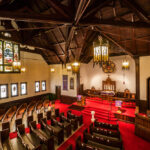
St. James Lutheran Church

National Cathedral
Saint John the Divine Cathedral
City
New York City
Venue
St. John the Divine
Address
1047 Amsterdam Avenue at 112th Street New York, NY 10025
Website
PROGRAM
CONDUCTOR: ANNA UNGUREANU
1. European Motets
John Leavitt – „Festival Sanctus”; piano: Abel Corban
Composer, conductor and teacher, John Leavitt's music continues to captivate listeners and musicians of all ages. "Festival Sanctus" is a hymn of praise to God. The major key in which it is written as well as the organic symbiosis of choir and piano accompaniment all contribute to a bright and joyful soundscape. The piece has been performed over the years in countless concerts by the National Chamber Choir "Madrigal - Marin Constantin", together with bands and children's choirs enrolled in the National Cantus Mundi Program.
Tomas Luis de Victoria – „Ave Maria”
Tomas Luis de Victoria's music has a special depth that contains a mystical fervor that is hard to describe in words. Based on the notions of counterpoint technique learned from his masters, the composer has succeeded in inducing a unique dramatic feeling pigmented with Spanish nuances specific to his native region. The tactfully created sound images are highly expressive, managing to emphasize the beauty of prayer in a transparent and harmonious way.
Claudio Monteverdi – „Cantate Domino”
Italian composer, choral conductor and instrumentalist, Claudio Monteverdi distinguished himself mainly in the compositional direction of the madrigal and the motet, being at the same time a forerunner in the emergence and development of opera, as well as an important figure in the transition from the Renaissance to the Baroque musical period. His motet, "Cantate Domino", is an exuberant work characterized by a harmonious balance between its moments. The dynamic variety adds a vitality to the work that easily reaches the listener's soul.
2. English Madrigals
Thomas Morley – „Now is the Month of Maying
Renaissance composer, theorist, singer and organist, Thomas Morley is one of the best known representatives of the English School of the period. "Now is the Month of Maying" reveals the joy and exuberance that floods all beings at the coming of spring, the exuberance, joy and passion that metaphorically invites us to live love in the present and enjoy youth.
Thomas Weelkes – „On the Plains”;
Weelkes is portrayed as a skilled composer whose genius shone on the English Renaissance music scene for more than a decade. The piece reveals an idyllic landscape of nymphs and satyrs dancing and loving in the green fields.
Francis Pilkington – „Rest Sweet Nymphs”;
"Rest Sweet Nymphs" is a sensitive work whose subject matter is rooted in the bucolic tradition. This nocturnal setting that emerges from the harmonious collaboration of music and poetry describes the story of a shepherd boy who wishes to steal an innocent kiss from a nymph resting in the forest. The melody's contours are smooth, like a lullaby in which sweet sleep comes gently on lute strings.
3. Romanian Christmas Carols
Ion Costescu, Alexandru Podoleanu – „Bună dimineața la Moș Ajun” și Costică Andrei – „Florile dalbe”
Prominent representatives of Romanian choral music, Ion Costescu, Alexandru Podoleanu and Costică Andrei reveal in the above triptych idyllic images of the Romanian village where the Nativity of the Christ Child is the main theme of the oldest form of caroling of children and young people; they walk from one house to another with good wishes for all the people present.
Dumitru Georgescu Kiriac – „O, ce veste minunată”
Romanian composer, teacher, choir conductor and folklorist, Dumitru Georgescu Kiriac (1866 - 1928) was one of the most important promoters of the roots of Romanian folklore. The carolers resemble the angels who announced the shepherds about the birth of the Saviour; the shepherds went on to the stable to worship the Lord.
Nicolae Ursu – „Vine Crăciunu` pe sară”
Composer, ethnomusicologist and teacher, Nicolae Ursu was a leading representative of Romanian choral music in the 20th century. His work is rich and varied, ranging from symphonic music to chamber, choral and vocal music. The folk-inspired carol "Vine Crăciunu` pe sară" (Christmas is coming tonight) reveals the preparations of the village people in anticipation of Christmas. Basil, a plant of spiritual importance in the Romanian folk tradition, is mentioned here, as something bringing happiness, health and good luck.
Sabin Păutza – „Noi venim să colindăm”
Born in 1943 in Câlnic, near Reșița, Sabin Păutza graduated from the "Ciprian Porumbescu" Conservatory in Bucharest, where he specialized in conducting and composition, and perfected his studies at the "Accademia Musicale Chigiana" in Siena (Italy). His works range from chamber music to symphonic music, from choral pieces to jazz compositions, with a contemporary compositional language influenced by jazz, negro spirituals and Romanian folklore. The opening of the carol "Noi venim să colindăm" imitates the bells sometimes used by carolers when they go caroling in the village. As the New Year approaches, the wishes made are for abundance, health, joy and good luck in all aspects of life.
Nicolae Lungu - „Mărire-ntru cele-nalte”
Known as "The Musician Priest", Nicolae Lungu dedicated his life to both music and the Church, having studied both fields, studies that left their unique mark on the composer's artistic vision. It is said that on Christmas night the sky opens and man has the opportunity to become better through enlightenment and spiritualization.
4. A Christmas Blessing
Elaine Hagenberg – „Alleluia”
Elaine Hagenberg’s music “soars with eloquence and ingenuity” (ACDA Choral Journal). Her compositions are performed worldwide and frequently featured at national and regional American Choral Directors Association Conferences, All-State festivals, Carnegie Hall, and other distinguished international concert halls from Australia to South America and throughout Europe. In addition to composing full-time, Elaine actively engages in bringing her music to life as the guest artist and featured clinician for professional conferences and festivals both in the U.S. and abroad as a composer, conductor, and accompanist for her work. (elainehagenberg.com). The "Alleluia" is based on a text written by St. Augustine (354 - 430), which is often known as a resurrection prayer.
Lloyd Larsson - „A Christmas Blessing”; la pian - Abel Corban; percuție: Florentina Pușcoi
Since 1982, Lloyd Larsson has made a name for himself as a composer of music for church choirs and school bands. His published works include more than 1,000 religious hymns, Christmas and Easter songs as well as individual works. "A Christmas Blessing" is a blessing to all listeners, a song of glory worshipped to God with gratitude.
Ticketing Information
